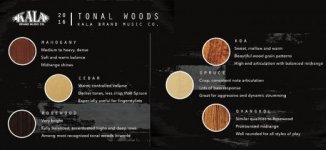Hochapeafarm
Well-known member
Thanks so much, everyone, for sharing all of your awesome thoughts and experiences — it’s incredibly helpful to me! I truly appreciate having all of your ideas, here, to give me a much broader perspective, as well as also giving me a great deal of insight!
I thought that I’d mention that another element I’m adding to my consideration in selecting woods is what I feel works best for my vocal range. Over the years I’ve been playing, I’ve found that certain woods suit my range (and style) better. I have a pretty loud voice — more of a ‘chest voice,’ I’d say, than a ‘head voice’ as a singer.
As was mentioned, strings can also help in the voicing of an instrument and I’ve been experimenting with different brands and kinds over the years. I have to be somewhat careful in string selection, tho, because I have pretty bad wrist tendinitis, so I try to use strings with less tension. I’ve actually just ordered some Uke Logic soft tension strings from Joel — I’m excited to try them out.
In typing this, I suppose — if it’s possible to achieve this — I really would just love to have an instrument that’s a ‘jack of all trades’ kind of player, rather than being great at one thing or another: I only have enough $ for one build; I write and play a variety of music — I strum and I fingerpick; whatever I go with, I’d like my instrument to be able to be flexible in that regard. I know that there is no perfect solution — there will always be strengths, weaknesses, etc.
Time is also another element to add to the equation in choosing my configuration; I don’t know if all woods do this, but I do know many woods will ‘open up’ more as they age.
So many things to consider — and yes, absolutely, the luthier — I totally get that, too — thanks to all for pointing this out as well. I’ve actually just reached out to a luthier a bit earlier this week.
We’ll see what happens; I’m super excited to have started this journey! Thank you so much, again, to you all for your time and input — it means a lot to me to see your feedback!
I thought that I’d mention that another element I’m adding to my consideration in selecting woods is what I feel works best for my vocal range. Over the years I’ve been playing, I’ve found that certain woods suit my range (and style) better. I have a pretty loud voice — more of a ‘chest voice,’ I’d say, than a ‘head voice’ as a singer.
As was mentioned, strings can also help in the voicing of an instrument and I’ve been experimenting with different brands and kinds over the years. I have to be somewhat careful in string selection, tho, because I have pretty bad wrist tendinitis, so I try to use strings with less tension. I’ve actually just ordered some Uke Logic soft tension strings from Joel — I’m excited to try them out.
In typing this, I suppose — if it’s possible to achieve this — I really would just love to have an instrument that’s a ‘jack of all trades’ kind of player, rather than being great at one thing or another: I only have enough $ for one build; I write and play a variety of music — I strum and I fingerpick; whatever I go with, I’d like my instrument to be able to be flexible in that regard. I know that there is no perfect solution — there will always be strengths, weaknesses, etc.
Time is also another element to add to the equation in choosing my configuration; I don’t know if all woods do this, but I do know many woods will ‘open up’ more as they age.
So many things to consider — and yes, absolutely, the luthier — I totally get that, too — thanks to all for pointing this out as well. I’ve actually just reached out to a luthier a bit earlier this week.
We’ll see what happens; I’m super excited to have started this journey! Thank you so much, again, to you all for your time and input — it means a lot to me to see your feedback!


